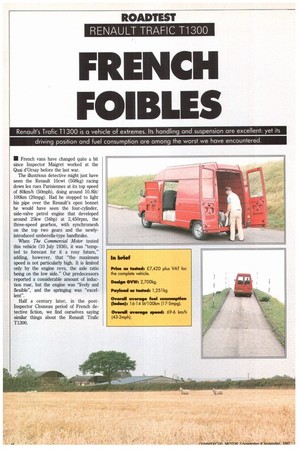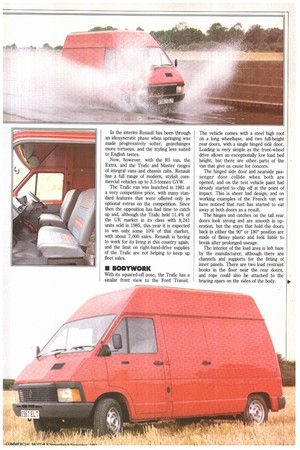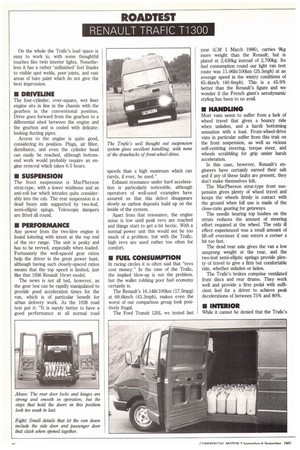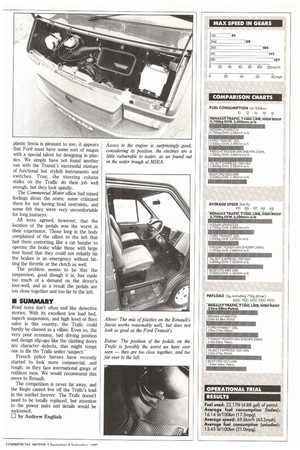FRE NCH FOIBL
Page 48

Page 49

Page 50

Page 51

If you've noticed an error in this article please click here to report it so we can fix it.
Renault's Trafic Ti 300 is a vehicle of extremes. lts handling and suspension are excellent: yet its driving position and fuel consumption are among the worst we have encountered.
• French vans have changed quite a bit since Inspector Maigret worked at the Quai d'Orsay before the last war.
The illustrious detective might just have seen the Renault lOcwt (508kg) racing down les rues Parisiennes at its top speed of 801anth (50mph), doing around 10.8lit/ 100km (26mpg). Had he stopped to light his pipe over the Renault's open bonnet he would have seen the four-cylinder, side-valve petrol engine that developed around 25kw (34hp) at 2,450rpm, the three-speed gearbox, with synchromesh on the top two gears and the newlyintroduced umberella-type handbrake.
When The Commercial Motor tested this vehicle (10 July 1936), it was "tempted to forecast for it a rosy future," adding, however, that "the maximum speed is not particularly high. It is limited only by the engine revs, the axle ratio being on the low side." Our predecessors reported a considerable amount of inducfion roar, but the engine was "lively and flexible", and the springing was "excellent".
Half a century later, in the postInspector Clouseau period of French detective fiction, we find ourselves saying similar things about the Renault Trafic T1300. In the interim Renault has been through an idiosyncratic phase when springing was made progressively softer, gearchanges more tortuous, and the styling less suited to English tastes.
Now, however, with the R5 van, the Extra, and the Trafic and Master ranges of integral vans and chassis cabs, Renault has a full range of modern, stylish commercial vehicles up to 3.5-tonnes GVW.
The Trafic van was launched in 1981 at a very competitive price, with many standard features that were offered only as optional extras on the competition. Since then the opposition has had time to catch up and, although the Trafic held 11.4% of the UK market in its class with 8,241 units sold in 1985, this year it is expected to win only some 10% of that market, with about 7,000 sales. Renault is having to work for its living in this country again, and the limit on right-hand-drive supplies of the Trafic are not helping to keep up fleet sales.
• BODYWORK
With its squared-off nose, the Trafic has a similar front view to the Ford Transit. The vehicle comes with a steel high roof on a long wheelbase, and two full-height rear doors, with a single hinged side door. Loading is very simple as the front-wheel drive allows an exceptionally low load bed height, but there are other parts of the van that give us cause for concern.
The hinged side door and nearside passenger door collide when both are opened, and on the test vehicle paint had already started to chip off at the point of impact. This is sheer bad design, and on working examples of the French van we have noticed that rust has started to eat away at both doors as a result.
The hinges and catches on the tall rear doors look strong and are smooth in operation, but the stays that hold the doors back in either the 90° or 180° position are made of flimsy plastic and look liable to break after prolonged useage.
The interior of the load area is left bare by the manufacturer, although there are channels and supports for the fitting of inner panels. There are two load restraint hooks in the floor near the rear doors, and rope could also be attached to the bracing spars on the sides of the body. On the whole the Trafic's load space is easy to work in, with some thoughtful touches like twin interior lights. Nonetheless it has a rather 'unfinished' feel thanks to visible spot welds, poor joints, and vast areas of bare paint which do not give the best impression.
• DRIVELINE
The four-cylinder, over-square, wet liner engine sits in line in the chassis with the gearbox in the conventional position. Drive goes forward from the gearbox to a differential sited between the engine and the gearbox and is cooled with delicatelooking ducting pipes.
Access to the engine is quite good, considering its position. Plugs, air filter, distributor, and even the cylinder head can easily be reached, although bottomend work would probably require an engine removal which takes 6.5 hours.
• SUSPENSION
The front suspension is MacPherson strut-type, with a lower wishbone and an anti-roll bar which intrudes quite considerably into the cab. The rear suspension is a dead beam axle supported by two-leaf, semi-elliptic spings. Telescopic dampers are fitted all round.
• PERFORMANCE
Any power from the two-litre engine is found loitering with intent at the top end of the rev range. The unit is peaky and has to be revved, expecially when loaded_ Fortunately the well-spaced gear ratios help the driver in the great power hunt, although having such closely-spaced ratios means that the top speed is limited, just like that 1936 Renault 10cwt model.
The news is not all bad, however, as the gear box can be rapidly manipulated to provide good acceleration times for the van, which is of particular benefit for urban delivery work. As the 1936 road test put it: "It is surely better to have a good performance at all normal road speeds than a high maximum which can rarely, if ever, be used."
Exhaust resonance under hard acceleration is particularly noticeable, although operators of well-used examples have assured us that this defect disappears slowly as carbon deposits build up on the inside of the system.
Apart from that resonance, the engine noise is low until peak revs are reached and things start to get a bit hectic. With a normal power unit this would not be too much of a problem, but with the Trafic, high revs are used rather too often for comfort.
• FUEL CONSUMPTION
In racing circles it is often said that "revs cost money." In the case of the Trafic, the implied blow-up is not the problem, but the wallet robbing poor fuel economy certainly is.
The Renault's 16.141k/100km (17.5mpg) at 69.6km/h (43.3mph), makes even the worst of our comparison group look positively frugal.
The Ford Transit 120L we tested last year (CM 1 March 1986), carries 9kg more weight than the Renault, but is plated at 2,630kg instead of 2,700kg. Its fuel consumption round our light van test route was 11.061it/100km (25.5mpti) at an average speed in the wintry conditions of 65.4krn/h (40.6mph). This is a 45.9% better than the Renault's figure and we wonder if the French giant's aerodynamic styling has been to no avail.
• HANDLING
Most vans seem to suffer from a lack of wheel travel that gives a bouncy ride when unladen, and a harsh bottoming sensation with a load. Front-wheel-drive vans in particular suffer from this trait on the front suspension, as well as vicious self-centring steering, torque steer, and wheels scrabbling for grip under harsh acceleration.
In this case, however, Renault's engineers have certainly earned their salt and if any of these faults are present, they don't make themselves felt.
The MacPherson strut-type front suspension gives plenty of wheel travel and keeps the wheels firmly in contact with the ground when full use is made of the close-ratio gearing for getaways.
The needle bearing top bushes on the struts reduces the amount of steering effort required at the wheel. The only ill effect experienced was a small amount of lift-off oversteer if one enters a corner a bit too fast.
The dead rear axle gives the van a low unsprung weight at the rear, and the two-leaf semi-elliptic springs provide plenty of travel to give a firm but comfortable ride, whether unladen or laden.
The Trafic's brakes comprise ventilated front discs and rear drums. They work well and provide a firm pedal with sufficient feel for a driver to achieve peak decelerations of between 75% and 80%.
• INTERIOR
While it cannot be denied that the Trafic's plastic fascia is pleasant to use, it appears that Ford must have some sort of magus with a special talent for designing in plastics. We simply have not found another van with the Transit's successful mixture of functional but stylish instruments and switches. True, the steering column stalks on the Traffic do their job well enough, but they look spindly.
The Commercial Motor office had mixed feelings about the seats; some criticized them for not having head restraints, and some felt they were very uncomfortable for long journeys.
All were agreed, however, that the location of the pedals was the worst in their experience. Those long in the body complained of the offset to the left that had them contorting like a cat burglar to operate the brake while those with large feet found that they could not reliably hit the brakes in an emergency without hitting the throttle or the clutch as well.
The problem seems to be that the suspension, good though it is, has made too much of a demand on the driver's foot-well, and as a result the pedals are too close together and too far to the left.
• SUMMARY
Road tests don't often end like detective stories. With its excellent low load bed, superb suspension, and high level of fleet sales in this country, the Trafic could hardly be classed as a villain. Even so, the very poor economy, bad driving position and design slip-ups like the clashing doors are character defects, that might tempt one to file the Trafic under 'suspect.'
French police heroes have recently started to look more commercial, and tough, as they face international gangs of ruthless men. We would recommend this move to Renault.
The competition is never far away, and the Regie cannot live off the Trafic's lead in the market forever. The Trafic doesn't need to be totally replaced, but attention to the power units and details would be welcomed.
by Andrew English




























































































